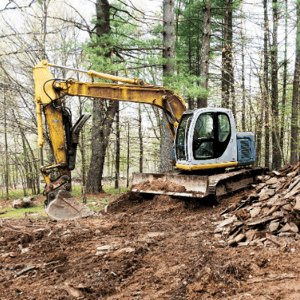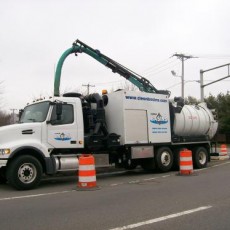How Excavator can Save You Time, Stress, and Money.
Wiki Article
The Best Guide To Demolition
Table of ContentsThe Of Excavation Contractors Near MeEverything about Excavation CompaniesExcavation Companies for Beginners6 Easy Facts About Excavating Contractors Shown5 Easy Facts About Excavation Companies Described


Scrapers or Pans dig deep into dirt in one location, haul and also dispose the dirt in another area (grading contractors). It is tough to match the effectiveness of scrapers for cut/fill soil operation if the haul distance is less then a mile. Scrapers are usually drawn by a rubber tire wheel tractor and are often pressed with the cut area by an excavator.
There are lot of times that scrapes are not utilized for website grading and a dump truck is employed: the haul might be to long, the haul might go across roadways where scrapers are not permitted, difficult rock may be come across, devices schedule, and so on. Discard vehicles remain in typical use as well as most likely need little conversation.
"Rock body" beds, on the various other hand, have no tailgates as well as can dispose any dimension rock, although their volume capacity is lessened. Compaction Devices increases the thickness of the soil and in some instances gives a smooth, rolled surface.
Facts About Concrete Contractors Revealed
From a simple examination pit to percussion boring to core drilling the proprietor has progressively much more pricey alternatives that generate progressively far better data concerning the website underground. For example, the Owner on a 100,000 SF building project may authorize twenty boring locations with split spoon dirt examples taken up until rock is reached and afterwards core examples of rock.Knowing the type and top quality of rock (from the core samples) and area of rock (from the soils boring) is a genuine advantage in jobsite preparation. Alternatively, the Proprietor of a 100,000 SF building might determine to proceed with no geotechnical testing whatsoever. The choice regarding geotechnical testing is generally made by a Proprietor with no input from the Construction Manager.
An understanding of the approximate location of the rock helps the Building Manager to plan the series of steps adhering to rock excavation. If rock is in one corner of a huge building job, for instance, the planet excavation might start at the opposite end of the building in order to begin foundation work soonest.
Starting the structure work early would be an excellent suggestion if the rock could be gotten rid of by tearing. If the rock is very difficult and also calls for substantial blasting, it may be sensible to hold foundation job until the blasting is completed. The Construction Supervisor must coordinate these sorts of choices and use all the technical day readily available.
The Only Guide for Excavating Contractors
Unclassified excavation specifies that all rock or other unforeseen products (omitting harmful materials) run into in the sitework will be the duty of the Specialist at no change in contract price. An unclassified excavation is less complex from a book-keeping perspective and also places the obligation for geotechnical conditions onto the this link Sitework Service provider.It's amazing what a hefty rainfall can do to a building task. Prior to the rain, the website might be dry, heavy devices successfully relocating planet, the other trades smoothly executing their job.
In many areas of the globe, the Construction Supervisor have to remember a basic fact: IT WILL RAINFALL. Excellent planning can lessen the damage and disruption of a heavy rain to a jobsite. Typically the excavation as well as grading is delegated the Sitework Specialist (and also their Foremen is accountable to oversee as well as guide the hefty devices and also drivers).
For That Reason the Construction Manager need to be constantly conscious of what rain will do to the project website. It is not unusual for the Sitework Foreman to work their hefty tools for optimal performance and also wish it does not rain. One of the very best ways to prepare for rainfall is to slope all grades to drain pipes and also to smooth rolled the surface prior to a rain.
Some Known Details About Grading Contractors
The Building Manager have to be well-balanced sufficient to guarantee that heavy rainfall does not quit work on the project much longer than required. Daily conversations with Sitework Foremen might be required to achieve this objective. Whenever excavation is called for listed below the existing water table on a project, the procedure of dewatering have to be taken into consideration.In a really cohesive dirt, the water travels so slowly with the clay or silt that dewatering is not normally required for the relatively short time of excavation. Dewatering might be needed for a solitary footing excavation or for an entire task website. The most common dewatering methods are trench drains pipes, deep wells and also well factors.

Ground water seepage can additionally be decreased by cutoff techniques such as sheet loading. The expenses for dewatering can be incredible, consisting of tools leasing, labor and electricity (or gas). High dewatering costs have actually paled the earnings margins on far a lot of projects. The several variables listed here make the job of approximating dewatering costs really challenging, and really inexact.
This option should constantly be thought about when evaluating the possibility of dewatering. Obviously the choice is just practical if gravity can run the water to reduced ground. Trench drains pipes can be reduced with a backhoe and loaded with a rugged, granular product (# 4 rock for instance), yet care should be worked out in choosing the water outlet type and also location.
Some Known Details About Mini Excavator
A siphon, necessarily, uses air pressure to lug water from one elevation, up over a barrier, to a lower elevation. The pipelines in a siphon system have to be airtight and some ingenuity is typically required independence excavating to completely fill the siphon pipeline. The siphon pipeline should be full for the siphon to start.A deep well includes a pump, hose pipe and also a vertical well casing. The pump consumption is at the base of the well housing (generally some crushed stone is positioned down there as a filter medium) (concrete contractors). The water is inflated the tube, out of the well housing, as well as to a suitable discharge location.
In a crude sand, as an example, a big location can be pumped to near the pump consumption elevation. A less absorptive dirt, on the other hand, minimizes the performance of a deep well. Considering that trenching contractors the pump is typically at the end of the deep well, there are no elevation constraints due to vacuum lift, as well as deep wells can reduce the groundwater over 50 feet.
Under of the wellpoint there is a 2 foot long display and also shutoff, water jets out of this valve and also develops an opening into which the wellpoint pipe can be reduced. This opening is often made a larger diameter (for instance 10 inches) to enable for a rugged sand backfill to assist filter the water (trencher).
Report this wiki page